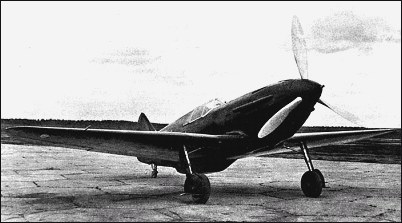|
| Semyon A Lavochkin, together with V P Gorbunov and
M I Gudkov, established a new design bureau in September
1938, and began work on a single-seat tactical
fighter. Initially designated I-22, the fighter was novel
in that plastic-impregnated wood known as delta drevesina
was used extensively in its construction, with
stressed bakelite plywood skinning. Power was provided
by a 1,100hp Klimov M-105P engine with a 23mm
VYa-23V cannon mounted between the cylinder banks,
the remaining armament comprising two 12.7mm UB
machine guns in the forward upper decking. Work
began simultaneously on seven prototypes, and a preseries
of 100 fighters was laid down. The first prototype
was flown on 30 March 1940, the designation having
meanwhile been changed to LaGG-1. It demonstrated
inadequate range, ceiling and manoeuvrability, and
potentially dangerous handling characteristics. The exigencies
of the times did not permit fundamental redesign
of the fighter, and the Lavochkin team therefore initiated
a programme aimed at alleviating the more
serious of the fighter's defects. Improvements were
progressively introduced, while the design was subjected
to a thoroughgoing weight analysis. The large calibre
machine guns were replaced by 7.62mm
ShKAS guns, and the 23mm cannon gave place to one
of 20mm. Various palliatives for the handling shortcomings
were applied, and the first LaGG-1 prototype
to introduce these changes was referred to as the I-301
(from the numerical designation of the factory -
GAZ-301). This also featured redesigned outer wing
panels incorporating additional fuel tanks. The I-301
entered flight test on 14 June 1940, the modified aircraft
being assigned the designation LaGG-3
and most pre-series examples of the LaGG-1 being completed
to the later standard.
| WEIGHTS |
| Take-off weight | 3380 kg | 7452 lb |
| Empty weight | 2968 kg | 6543 lb |
| DIMENSIONS |
| Wingspan | 9.80 m | 32 ft 2 in |
| Length | 8.81 m | 29 ft 11 in |
| Height | 4.40 m | 14 ft 5 in |
| Wing area | 17.50 m2 | 188.37 sq ft |
| PERFORMANCE |
| Max. speed | 600 km/h | 373 mph |
| Range | 660 km | 410 miles |
| AceM7, e-mail, 06.02.2014 00:09 sorry I only said lag I didn't mean to I meant
laGG reply |
| AceM7, e-mail, 06.02.2014 00:07 the lag-3 is my favorite Russian plane I also use it in War Thunder anyway I wanted t see the lag-1 and I think its cool reply | | baiwang, 18.06.2011 11:08 LaGG-3 and most pre-series examples of the LaGG-1 being completed to the later standard. reply |
|
Do you have any comments?
|
| 
COMPANY
PROFILE
All the World's Rotorcraft
|







20
reply